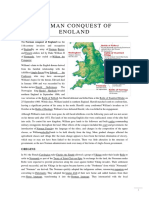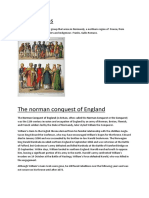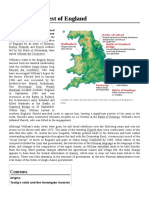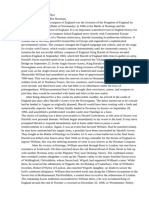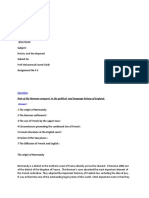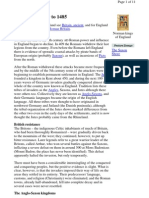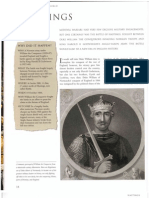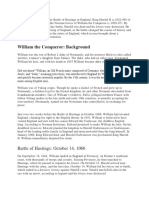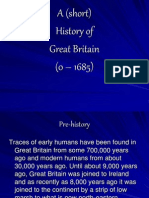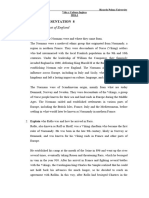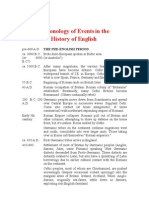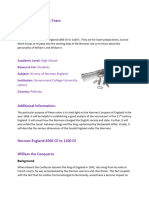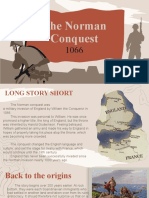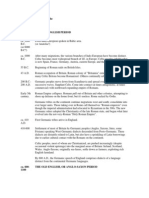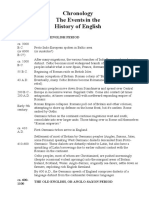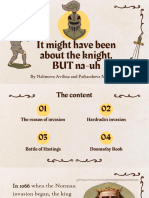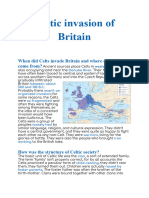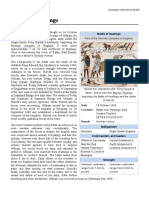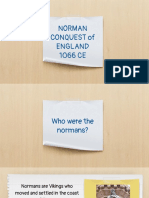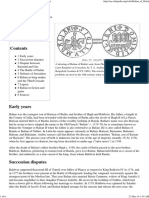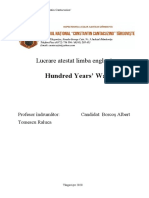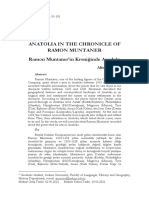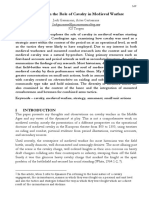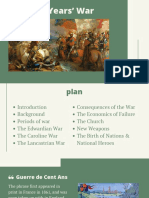Norman Conquest
Norman Conquest
Uploaded by
worldcupjb22Copyright:
Available Formats
Norman Conquest
Norman Conquest
Uploaded by
worldcupjb22Original Title
Copyright
Available Formats
Share this document
Did you find this document useful?
Is this content inappropriate?
Copyright:
Available Formats
Norman Conquest
Norman Conquest
Uploaded by
worldcupjb22Copyright:
Available Formats
### The Invasion
#### The Battle of Stamford Bridge
The first major conflict in the struggle for the English crown was the Battle of Stamford
Bridge on September 25, 1066. King Harold II of England faced Harald Hardrada's invading
force, which had allied with Tostig, Harold's exiled brother. Harold II's forces won a decisive
victory, killing Hardrada and Tostig. However, this victory came at a cost, as Harold's army
was left weakened and exhausted.
#### The Norman Invasion
While Harold II dealt with Hardrada in the north, William of Normandy prepared his invasion
in the south. William assembled a fleet and a formidable army, landing at Pevensey on the
Sussex coast on September 28, 1066. Harold marched his army south, covering the
distance from Stamford Bridge to the south coast remarkably quickly.
### The Battle of Hastings
#### Prelude
The two armies met near Hastings on October 14, 1066. William's forces, composed of
knights, infantry, and archers, faced Harold's army, which primarily consisted of housecarls
(elite soldiers) and the fyrd (local militia).
#### The Battle
The Battle of Hastings lasted an entire day and was marked by intense combat and strategic
maneuvers. Harold's forces initially held a strong defensive position on Senlac Hill. However,
William's use of feigned retreats to draw out and break the English shield wall proved
effective. Late in the battle, Harold was killed—reportedly struck in the eye by an arrow—
leading to the collapse of the English resistance.
### Aftermath and Consequences
#### William's Consolidation of Power
After his victory at Hastings, William faced several challenges to secure his control over
England. He marched to London, encountering resistance but ultimately securing the city's
submission. William was crowned king of England on Christmas Day 1066 in Westminster
Abbey. Over the next few years, William dealt with various uprisings and rebellions, using a
combination of military force and strategic alliances.
#### Changes in Land Ownership and Governance
The Norman Conquest brought significant changes to English land ownership and
governance. William rewarded his Norman followers with large tracts of land, dispossessing
many Anglo-Saxon nobles. This redistribution of land created a new ruling elite and laid the
foundation for the feudal system in England. The Domesday Book, commissioned by William
in 1085, documented landholdings and resources across England, providing a detailed
record of these changes.
#### Cultural and Linguistic Impact
The conquest had a profound impact on English culture and language. Norman French
became the language of the court, administration, and the elite, profoundly influencing the
development of the English language. Many French words entered the English lexicon,
especially in areas related to law, governance, art, and literature.
#### Architectural and Ecclesiastical Changes
Norman influence is also evident in architecture, with the construction of impressive stone
castles, cathedrals, and churches. These structures not only demonstrated the Normans'
military and religious power but also introduced Romanesque architectural styles to England.
### Legacy
The Norman Conquest fundamentally transformed England, shaping its future development.
The changes in land ownership, governance, language, and culture established new social
and political structures that influenced the country for centuries. The conquest also
strengthened ties between England and continental Europe, particularly France, affecting the
island's political landscape.
### Conclusion
The Norman Conquest of 1066 was a pivotal event that reshaped English society in
profound ways. The conquest resolved the succession crisis following Edward the
Confessor's death and established William the Conqueror as the new king. The subsequent
changes in land ownership, governance, language, and architecture left an indelible mark on
England's history, with effects that are still evident today. The Norman Conquest is not just a
tale of battles and power struggles but a transformative period that laid the foundations for
modern England.
You might also like
- Kristian Molin Unknown Crusader Castles 2003Document460 pagesKristian Molin Unknown Crusader Castles 2003buki1001100% (3)
- History UkDocument2 pagesHistory Ukworldcupjb22No ratings yet
- Edward: Invasion of EnglandDocument3 pagesEdward: Invasion of EnglandManu JamesNo ratings yet
- Unit 3Document10 pagesUnit 3Naiara MestanzaNo ratings yet
- The Unification of EnglandDocument21 pagesThe Unification of EnglandHolda GómezNo ratings yet
- The Norman ConquestDocument13 pagesThe Norman ConquestkivaiericNo ratings yet
- Norman Conquest - WikipediaDocument18 pagesNorman Conquest - WikipediaMaverick' ChurchNo ratings yet
- JEEN11Document90 pagesJEEN11rraja842047No ratings yet
- Cultura Puntos ImportantesDocument54 pagesCultura Puntos ImportantesalejandraNo ratings yet
- Lecture I HistoryDocument16 pagesLecture I HistoryBiaNo ratings yet
- The NormansDocument2 pagesThe NormansBianca LP100% (1)
- Norman Conquest: Conquest) Was The 11th-CenturyDocument18 pagesNorman Conquest: Conquest) Was The 11th-Centuryallen100% (1)
- Norman Conquest of England: Conquest or The Conquest) Was TheDocument18 pagesNorman Conquest of England: Conquest or The Conquest) Was TheclubmailusNo ratings yet
- Реферат Лавро Т.И УА-19-1зDocument4 pagesРеферат Лавро Т.И УА-19-1зТатьяна ЛужненкоNo ratings yet
- History of BritainDocument13 pagesHistory of BritainTrung NguyễnNo ratings yet
- Norman Conquest of EnglandDocument16 pagesNorman Conquest of EnglandAhmed SharifNo ratings yet
- Cultura Si Civilizatie Britanica Lect. Univ. Dr. Ioana RaicuDocument16 pagesCultura Si Civilizatie Britanica Lect. Univ. Dr. Ioana RaicuPaulescu Daniela AnetaNo ratings yet
- Самостоятельная работа по регионоведение Группа: RRGM-209 Студент: Садыгова Джамила. Тема: Norman conquest in BritainDocument4 pagesСамостоятельная работа по регионоведение Группа: RRGM-209 Студент: Садыгова Джамила. Тема: Norman conquest in Britainaygul veliyevaNo ratings yet
- The Importance of The Norman Invasion.Document1 pageThe Importance of The Norman Invasion.Вероника ДушевскаяNo ratings yet
- СРС 4Document2 pagesСРС 4quanovanNo ratings yet
- Assignment 3 Prof M Saeed SBDocument3 pagesAssignment 3 Prof M Saeed SBUmair MakhdoomNo ratings yet
- PHRS UK To 1485Document11 pagesPHRS UK To 1485sallyfrankenwarteNo ratings yet
- The Norman Conquest: By: Jam Mari O. MoldezDocument46 pagesThe Norman Conquest: By: Jam Mari O. MoldezJam Mari MoldezNo ratings yet
- Norman Conquest ScriptDocument3 pagesNorman Conquest ScriptMadiNo ratings yet
- Pp.18 39.hastings LegnanoDocument22 pagesPp.18 39.hastings Legnanozesoy100% (1)
- Battle of HastingsDocument28 pagesBattle of HastingsTaru VaidNo ratings yet
- William The Conqueror: Background: Battle of Hastings: October 14, 1066Document2 pagesWilliam The Conqueror: Background: Battle of Hastings: October 14, 1066Rima AzzahraNo ratings yet
- Norman ConquestDocument36 pagesNorman ConquestManu JamesNo ratings yet
- The Impact and Consequences of The Norman Conquest: Zeribi Sara Ben Jeddou Inas Khouldia SarraDocument8 pagesThe Impact and Consequences of The Norman Conquest: Zeribi Sara Ben Jeddou Inas Khouldia SarraYusef KhNo ratings yet
- Topic 42Document8 pagesTopic 42Haydée PalomoNo ratings yet
- Introduction To The Anglo-Norman Period: North of France. King CharlesDocument28 pagesIntroduction To The Anglo-Norman Period: North of France. King CharlesAli KhanNo ratings yet
- BayeuxTapestry TextDocument6 pagesBayeuxTapestry TextAnita Marie Wilson-nourseNo ratings yet
- History of BritainDocument72 pagesHistory of BritainoierulNo ratings yet
- British Culture and Civilization - CourseDocument30 pagesBritish Culture and Civilization - CourseBuzatu Alina0% (1)
- Presentation 8Document5 pagesPresentation 8natalieramosfoglia18No ratings yet
- Duke William of Normandy Also Known As William The BastardDocument5 pagesDuke William of Normandy Also Known As William The BastardjobacegaNo ratings yet
- Chronology of Events in The History of EnglishDocument7 pagesChronology of Events in The History of Englishlb0336No ratings yet
- Athelred and Canut: The Decline of The English MonarchyDocument1 pageAthelred and Canut: The Decline of The English MonarchyMariana VilcaNo ratings yet
- Norman England 1 1 1Document4 pagesNorman England 1 1 1zuugwe 2No ratings yet
- Hastings History PDFDocument5 pagesHastings History PDFBrett Michael ChinchenNo ratings yet
- Cultura Si Civilizatia Marii BritaniiDocument7 pagesCultura Si Civilizatia Marii BritaniiMariutza Chirtoaca100% (1)
- The Norman Conquest Ist UkDocument13 pagesThe Norman Conquest Ist UkEMA GABRIELA ROTUNJANUNo ratings yet
- 05a. KB5 Establishing ControlDocument11 pages05a. KB5 Establishing Controlnexywyd496No ratings yet
- Textual Practice. 2 - Gal CarolinaDocument6 pagesTextual Practice. 2 - Gal Carolinagalcarolina722202No ratings yet
- GB Syn - Hist 1. (Dark Ages-17th Cent.)Document8 pagesGB Syn - Hist 1. (Dark Ages-17th Cent.)Sophia IvasechkoNo ratings yet
- TheDocument1 pageThesukidhaliwal145No ratings yet
- Chronology of Events in The History of EnglishDocument7 pagesChronology of Events in The History of EnglishJhoa OrtegaNo ratings yet
- HIST 2000 MidtermDocument3 pagesHIST 2000 Midtermzcolli01No ratings yet
- CHP 1 SummaryDocument3 pagesCHP 1 SummarysebgroganNo ratings yet
- Chronology History EnglishDocument6 pagesChronology History EnglishІнна ДжураNo ratings yet
- Referat EnglezaDocument5 pagesReferat Englezaarwen_undomielNo ratings yet
- The Norman ConquestDocument7 pagesThe Norman ConquestElias VeturiusNo ratings yet
- It Might Have Been About The Knight, BUT Na-UhDocument19 pagesIt Might Have Been About The Knight, BUT Na-UhRita PaibarshevaNo ratings yet
- Invasions of BritainDocument6 pagesInvasions of Britaingaia.lombisaniiNo ratings yet
- Battle of HastingsDocument18 pagesBattle of HastingsjiannissavoulNo ratings yet
- William I's Suppression of Rebellions, His Military Qualities, Castle Building and The New Norman Elite, The Harrying of The NorthDocument10 pagesWilliam I's Suppression of Rebellions, His Military Qualities, Castle Building and The New Norman Elite, The Harrying of The NorthJamaliNo ratings yet
- Norman ConquestDocument35 pagesNorman Conquestapi-463690129No ratings yet
- The Crusades ChartDocument4 pagesThe Crusades Chartapi-314810534No ratings yet
- Italian WarsDocument7 pagesItalian WarsJosé María Bravo LinerosNo ratings yet
- Negroponte IslandDocument39 pagesNegroponte Islandclaudiu dobreNo ratings yet
- The CrusadesDocument48 pagesThe CrusadesAnonymous kielG2100% (1)
- Khalid Bin WaleedDocument30 pagesKhalid Bin WaleedahmadjandolaNo ratings yet
- Balian of Ibelin - Wikipedia, The Free EncyclopediaDocument6 pagesBalian of Ibelin - Wikipedia, The Free EncyclopediaJulie MerrillNo ratings yet
- Lucrare Atestat Limba EnglezăDocument14 pagesLucrare Atestat Limba EnglezăAlbert BorcosNo ratings yet
- Anatolia in The Chronicle ofDocument13 pagesAnatolia in The Chronicle ofMoliereNo ratings yet
- Ain Jalut BattleDocument3 pagesAin Jalut BattleYusak NugrohoNo ratings yet
- Renaissance Beta Lists: SAMURAI 1550-1600 AD - Last Update 1 September 2009Document2 pagesRenaissance Beta Lists: SAMURAI 1550-1600 AD - Last Update 1 September 2009FranzisLandwehrNo ratings yet
- The Crusades Revision QuizDocument18 pagesThe Crusades Revision Quizapi-216576827No ratings yet
- KVK 4Document2 pagesKVK 4LOG BMSNo ratings yet
- Thoughts On The Role of Cavalry in Medieval WarfareDocument29 pagesThoughts On The Role of Cavalry in Medieval WarfarePatrick JenkinsNo ratings yet
- Noth & Conrad (1994) The Early Arabic Historical Tradition, III TopoiDocument64 pagesNoth & Conrad (1994) The Early Arabic Historical Tradition, III TopoiEmber lordofFireNo ratings yet
- The Norman Conquest - WorksheetDocument2 pagesThe Norman Conquest - Worksheetlukáš benkeiNo ratings yet
- MiddagessmlDocument9 pagesMiddagessmlAina FazlianaNo ratings yet
- Anglo Saxons and Normans Exam Qs 1 1Document5 pagesAnglo Saxons and Normans Exam Qs 1 1BeheshtaNo ratings yet
- MTW-VI Viking Tech TreeDocument1 pageMTW-VI Viking Tech TreeNikola DotaNo ratings yet
- Sack of AmoriumDocument7 pagesSack of AmoriumMartin SkodaNo ratings yet
- Are Westerosi Armies PeasantsDocument13 pagesAre Westerosi Armies PeasantsToni SusnjarNo ratings yet
- Bretonnia Army List (Ake's!)Document4 pagesBretonnia Army List (Ake's!)Lewis HampshireNo ratings yet
- Hundred Year's WarDocument20 pagesHundred Year's Warbaleine blancheNo ratings yet
- WRG Army Lists Book 3 1000AD-1485ADDocument54 pagesWRG Army Lists Book 3 1000AD-1485ADD Cassidy86% (7)
- Armies enDocument27 pagesArmies enpresswolf100% (1)
- Battle BrothersDocument5 pagesBattle BrothersAdrianNo ratings yet
- Kensei Catalog Feb 2014Document19 pagesKensei Catalog Feb 2014Salvador MiqueletNo ratings yet
- Richard The LionheartDocument2 pagesRichard The LionheartAndreea PopNo ratings yet
- Latinokratia ChronologyDocument7 pagesLatinokratia ChronologyAnthony S. CHATZIIOANNOUNo ratings yet
- Crusades WorksheetDocument5 pagesCrusades WorksheetBenjamin Mehrer100% (1)









